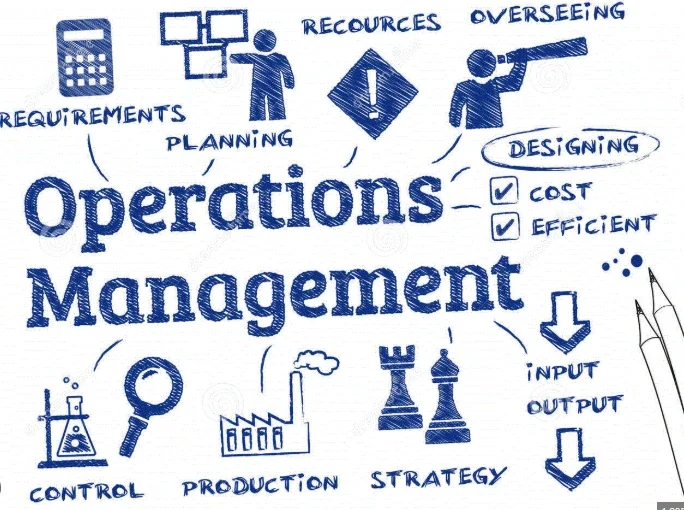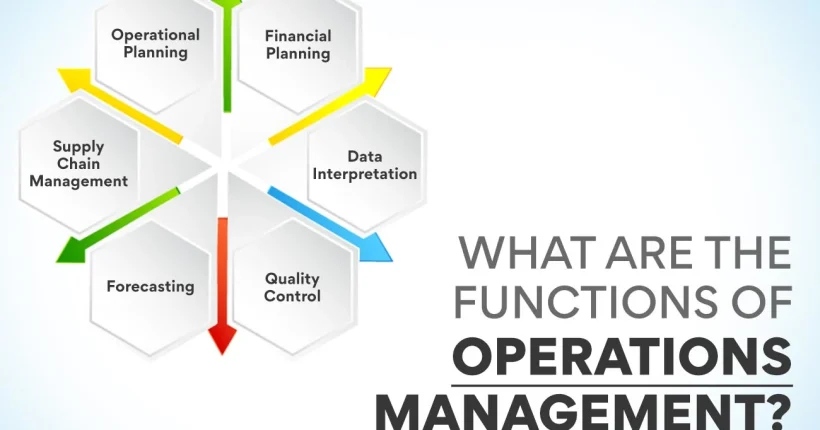Hello students!
Today, we’re going to explore something that quietly powers every successful business Operations Management. Whether it’s your favorite café, a hospital, a clothing brand, or a smartphone manufacturer, each of them relies on strong operations management to ensure things happen efficiently, on time, and with quality. Let’s take a deep look at what this concept really means and how it keeps businesses alive and competitive.

Table of Contents
Meaning of Operations Management
To understand the meaning of operations management, think about a restaurant. Every day, the owner must buy ingredients, hire chefs, schedule staff, prepare meals, serve customers, and maintain hygiene standards. All of these activities together—planning, organizing, coordinating, and controlling the daily functions—are examples of operations management in action.
Formally, Operations Management refers to the administration of business practices that transform resources like materials, labor, and technology into goods and services efficiently to achieve profitability and customer satisfaction. In simpler terms, it is about ensuring that everything in an organization works seamlessly to produce quality products or services at the right time and cost.
Operations management is not limited to factories or manufacturing plants. It applies equally to service sectors such as banking, healthcare, logistics, education, and entertainment. The main goal is always the same: to improve business efficiency, reduce waste, and maximize value for both the company and its customers.
The Operations Input–Process–Output Model
At the heart of operations management lies the input–process–output model, also known as the transformation model. Every organization can be viewed as a system where inputs are converted into outputs through a series of processes. The inputs include materials, labor, equipment, information, and capital. The process represents the actual transformation activities that take place to create value—this could mean manufacturing goods, providing a service, or processing data. The outputs are the final goods or services delivered to customers.
For example, in a hospital, patients, doctors, nurses, and medical equipment form the inputs. The treatment and diagnosis that occur inside the hospital are the processes, and the output is a healthy, satisfied patient. Similarly, in a restaurant, raw ingredients, chefs, and kitchen tools are inputs; the cooking and plating form the process; and the output is a delicious meal served to a happy customer.
The operations manager’s role is to ensure this entire flow—input to output—occurs efficiently, on schedule, and within budget. They act as the conductor of the system, ensuring every part of the process works in harmony.
Types of Transformation Process
The types of transformation process vary depending on the nature of the organization and what it produces. Broadly, these can be categorized into three main forms: material processing, information processing, and customer processing.
Material processing involves changing raw materials into finished products, as seen in manufacturing, construction, or mining industries. Information processing deals with transforming data into meaningful outputs, which is common in banks, research institutions, and IT companies. Customer processing occurs when the customer themselves is part of the transformation, as in hospitals, salons, and hotels, where people’s conditions or experiences are directly changed.
Beyond these broad types, there are other specific forms of transformation, such as physical transformation (changing the physical form of something, like machining or cooking), informational transformation (analyzing or updating data), possession transformation (changing ownership, like in retail sales), location transformation (transportation or delivery services), storage transformation (preserving items for future use, such as warehousing), and psychological or physiological transformation (affecting how a person feels, like in healthcare or entertainment).
These diverse forms of transformation show that operations management exists in every field, from a farmer producing crops to an IT company managing software updates.
Scope of Operations Management
The scope of operations management is broad and touches every aspect of an organization’s functioning. It can be understood at three levels: strategic, tactical, and operational.
At the strategic level, operations management focuses on long-term decisions that determine the direction of the organization. These include decisions about what products or services to produce, where to locate facilities, what technologies to use, and which markets to serve. Strategic decisions shape the foundation upon which all other operations rest.
The tactical level deals with medium-term planning, focusing on how to allocate resources effectively and coordinate processes to meet the organization’s goals. This involves scheduling production, managing inventory, maintaining quality, and planning capacity.
Finally, at the operational level, operations management involves day-to-day activities. It ensures that workers, machines, and materials are used efficiently and that production runs smoothly. Tasks such as managing staff shifts, handling maintenance, ensuring safety, and controlling daily production volumes all fall under operational scope.
Together, these three levels ensure that the organization operates efficiently from the top strategic decisions down to everyday operations.
Functions of Operations Management
The functions of operations management encompass everything from planning to controlling production and service delivery. The first and most critical function is planning—deciding what needs to be produced, how it will be produced, when, and by whom. Once plans are made, the next function is organizing, which involves arranging resources—materials, labor, and machines—in the most efficient way possible.
Another key function is staffing, where managers recruit, train, and assign employees to different tasks. This leads to directing, which means guiding and motivating staff to perform their duties effectively. Finally, there is controlling, which involves monitoring performance, ensuring quality, and making necessary adjustments when operations deviate from planned goals.
In addition to these main functions, operations management also includes activities like inventory management, scheduling, facility layout, maintenance, logistics, and project management. These collectively ensure smooth workflows, cost control, and consistent quality. Without these functions, no business can maintain efficiency or sustain profitability.
Operations Manager Roles
The roles of an operations manager are both strategic and practical. They oversee the transformation process, coordinate departments, and ensure the organization’s objectives are met. A good operations manager must balance efficiency with quality, ensuring products or services are delivered on time and within cost constraints.
They also play a key part in decision-making—analyzing data, forecasting demand, managing budgets, and improving processes. Moreover, operations managers are responsible for maintaining relationships with suppliers, coordinating logistics, and ensuring compliance with safety and regulatory standards. In essence, they bridge the gap between senior management’s vision and the daily activities that make that vision a reality.
Examples of Operations Management
Operations management appears in countless real-world situations. In manufacturing, it involves scheduling production lines, managing supply chains, and controlling quality. In healthcare, it ensures doctors and nurses are assigned efficiently, equipment is available, and patient care is consistent. In hospitality, it ensures guests receive timely service, rooms are cleaned, and meals are prepared to standard. Even in technology companies, operations management governs data center maintenance, software deployment, and customer support.
Each of these examples shows that operations management is not limited to one industry—it is the backbone of all industries that rely on planning, production, and service delivery.
Importance of Operations Management
The importance of operations management lies in its ability to create efficiency and stability in a business. Without it, costs rise, production slows, and customers become dissatisfied. Strong operations management ensures that resources are used wisely, waste is minimized, and products meet quality expectations.
Moreover, it directly impacts profitability. By improving efficiency, businesses can produce more with less, reducing operational costs. It also plays a crucial role in maintaining customer satisfaction, as timely delivery and consistent quality build trust and loyalty. In competitive markets, effective operations management gives companies the agility to respond to changing demands and new challenges.
Supply Chain Management Basics
An essential part of operations management is understanding supply chain management basics. The supply chain refers to the entire network of suppliers, manufacturers, distributors, and retailers involved in producing and delivering a product to the end customer. Managing this chain effectively is key to operational success.
Supply chain management includes sourcing raw materials, managing production, handling logistics, and ensuring products reach customers on time. It also involves maintaining good relationships with suppliers and sharing information across all stages to avoid bottlenecks. Efficient supply chain management helps reduce costs, improve delivery times, and enhance overall business efficiency. When operations management and supply chain management work hand-in-hand, the result is a smooth, synchronized flow of materials, information, and services.
Business Efficiency and Operations Management
Ultimately, operations management is all about achieving business efficiency—producing the best possible output with the least possible input. Techniques like lean production, just-in-time inventory systems, and total quality management have been developed to help organizations operate efficiently. By analyzing workflows, eliminating unnecessary steps, and automating repetitive tasks, operations managers ensure that time, money, and resources are not wasted.
This efficiency leads to better products, lower prices, and higher customer satisfaction—all of which contribute to long-term business success. In today’s competitive world, efficient operations can be the difference between thriving and merely surviving.
Conclusion
To summarize, operations management is the systematic direction and control of the processes that turn resources into products and services. It follows the input–process–output model and involves various types of transformation processes across different industries. The scope of operations management extends from long-term strategic planning to daily operational decisions, while the functions of operations management ensure that every stage of production or service delivery runs smoothly.
The operations manager’s role is crucial in coordinating people, technology, and systems to achieve organizational goals. Through effective management of resources, processes, and supply chains, operations management enhances business efficiency, reduces waste, and maintains competitiveness.
Whether it’s a bakery, hospital, airline, or software company, every successful organization runs on strong operations management. It is truly the heartbeat that keeps a business alive, efficient, and ready for the future.
External Sources:

